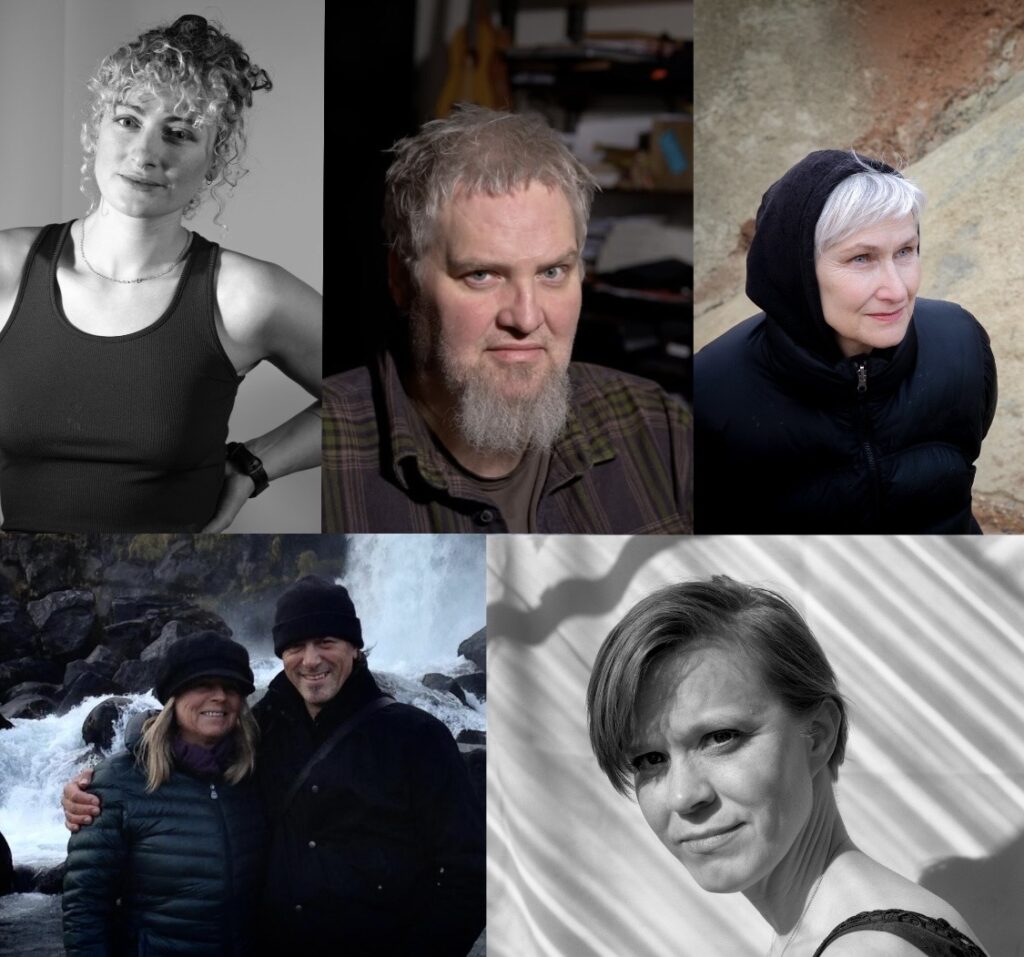Join us for an Artist Talk at the Nordic House with Ragna Róbertsdóttir, Erna Skúladóttir, Pétur Thomsen, Julie Sjöfn Gasiglia and Bryndís Snæbjörnsdóttir & Mark Wilson.
Snæbjörnsdóttir/Wilson eru íslensk-breskt listamannatvíeyki sem rannsakar tengsl manns og annarra lífvera í gegnum rannsóknardrifnar innsetningar, ljósmyndir, vídeó og texta. Frá því snemma á 21. öldinni hafa þau kannað menningarlegar og vistfræðilegar afleiðingar tilfærslu tegunda, útrýmingar og verndunar. Þekkt verkefni þeirra – eins og Visitations: Polar Bears Out of Place – sameina vettvangsrannsóknir, skjalasöfn og þverfaglegt samstarf til að spyrja hvernig við skilgreinum og hugum að öðrum lífverum, og afhjúpa þannig margbreytilegar og oft mótsagnakenndar afstöðu mannsins til náttúrunnar.
Time and Tide (2022) og Time and Again (2023) eru lóðrétt vídeóverk sem flétta saman hljóð og mynd með frásögnum af komu ísbjarna til Íslands. Þau kalla fram brothætt mót mannlegrar og ómannlegra sagna. Í samspili við skúlptúrverk víkka þau út frásagnaraðferðir um efni og vistfræði. Matrix (Svalbard) (2020), er handblásinn glerskúlptúr í hlutfallinu 1:20, miðað við raunverulegt ísbjarnarhýsi á Svalbarða. Skúlptúrinn byggir á vísindateikningum norskra rannsakenda og jarðtengir þemu verksins um búsvæði og nærveru í brothættri efnislegri mynd og ljósi. Úr innsetningunni The Secret Garden spretta Totemic Objects (2023), skúlptúrar úr rekaviði, leir og dýraleifum sem umbreytast í blendingaform, á mörkum minja og framtíðarsteingervinga. Þau vísa til samofins lífs og varnarleysis þess. Saman eru þessi verk hluti af langtímarannsóknarverkefninu Visitations, sem listamennirnir hlutu Íslensku myndlistarverðlaunin fyrir árið 2022, og halda áfram að kanna síbreytileg mörk á milli tegunda, landslags og goðsagna.
Erna Skúladóttir often engages with themes of time, geology, and environmental transformation. She documents the subtle yet profound impact of climate change on natural forms. Erna works with glacial and geological time, capturing the slow movements and transformations of Iceland’s landscapes. Her installations document the intersection of climate change and natural history, asking viewers to contemplate the scale and fragility of environments shaped over millennia.
In Yfirborð, Erna Skúladóttir meditates on the fragility and flux of geological materiality, exposing the illusion of solidity within landscapes. Her manipulation of unfired clay and natural materials speaks to the constant transformation occurring beneath the surface of seemingly stable matter. By working with materials that dry, crack, and decay over time, her installations insist on the viewer’s attunement to slow, almost imperceptible changes. Skúladóttir’s work translates geological processes into sculptural form, mirroring how time operates on both emotional and environmental scales.
Julie Sjöfn Gasiglia (b. 1990, France) is an Icelandic–French artist whose work is rooted in the exploration of narratives that interlace humans with the more-than-human world—the relationships that surround us and the ecosystems that dwell within our own bodies.
Her sculptures and installations become meditations on slowness, transformation, responsibility, and interconnectedness. These man-made creatures pose questions about the sustainability of systems and the dysfunctions that arise within them.
In a world of overstimulation, she offers an invitation to listen with the whole body, expanding our capacity to notice, feel, and respond to the living world.
Her multi-sensory installations foreground the intimate bonds between humans and more-than-human beings. Whether through speaker-embedded ceramics or movement-activated environments, her practice slows perception and fosters interspecies empathy. Sounds drawn from the artist’s own microbiome travel through fired clay, while the viewers’ presence influences the rhythm and flow of fluids—reminders of connections beyond language that invite a sensorial encounter.
Pétur Thomsen focuses on the transformation of land through human intervention. He examines the friction between industrial development and fragile ecosystems, creating images that are both documentary and critical. Pétur Thomsen turns his lens toward landscapes under transformation, documenting the encroachment of human intervention on natural systems. His long-term photographic series charts the incremental shifts in the land. Thomsen draws attention to the marks of human intervention; mines, tree plantations, and cultivated land. The stark contrasts and nocturnal stillness suggest a slow violence at work, change that creeps rather than crashes.
In Teigskógur, Pétur presents a series of photographs taken in the forest Teigskógur, capturing the aftermath of a violent human intervention in a once-pristine forest. The images document the moment when a mulcher was used to tear through the birch trees, clearing the way for a highly controversial road construction project. Presented in a grid, the close-up shots of shredded wood, broken branches, and disturbed moss lay bare the brutality of this mechanized intrusion. The repetition and variation across the frames evoke a sense of systematic destruction, making visible a slow violence often hidden in infrastructural development.
Ragna Róbertsdóttir is an Icelandic artist whose multidisciplinary practice explores the seasonal cycles of growth, decay, and regeneration through delicate, often ephemeral materials. Her work reflects on impermanence, crafting a visual language of slow unfolding, blossoming, withering, transforming, that speaks to nature’s quiet endurance. By working with materials like lava rock, turf, salt, and clay, Róbertsdóttir transforms geological processes into poetic gestures. Her compositions appear simple, yet they demand prolonged contemplation.
Ragna Róbertsdóttir’s minimalist sculptures and outdoor interventions Timescape, Saltscape, and Path are rooted in Iceland’s elemental materiality, evoking the slow erosion, formation, and sedimentation of the land itself. Each granule or fragment seems suspended in geological memory, marking the passage of millennia in a single crystalline gesture. These works operate as slow clocks, capturing the sediment of centuries and positioning nature not as a backdrop to human life, but as its measure and mirror. At the entrance of the Nordic House, copper plates are embedded into the ground, quietly catching light and weather over time, marking thresholds and inviting a slowed, attentive mode of arrival. She similarly marks a pathway in the marsh of Nordic House with fragments of red lava, stone, and sediment, creating a tactile and visual disruption that amplifies the terrain’s geological memory.
